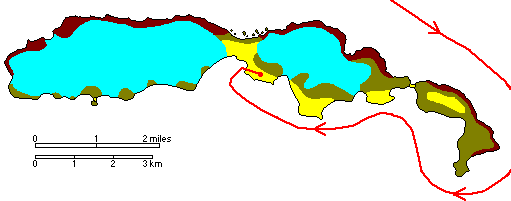January 11 - Arrival at Gibbs Island
Steven Dutch, Professor Emeritus, Natural and Applied Sciences, University of Wisconsin - Green Bay

We awoke on the morning of the 11th to find the temperature sharply colder and a glacier-covered island on the horizon. I hoped we would do some more sailing and see some more scenery, but I had studied the air photos of Gibbs Island and I knew immediately from the profile that we were there.
 |
Notice that the cliffs left of the deep notch have an obvious layered appearance while those to the right do not. The rocks left of the notch are schist, those to the right are dunite, a piece of the mantle broken off in a subduction zone. The boundary between the two is a thrust fault that slants through the notch from upper left to lower right (it's faintly visible as a color boundary.) We ended up using that notch as the easiest way to cross the island, but it's steeper than it looks (and about 300 feet high). |

 |
The deep notch right of the bow is a place where the main island is joined to a neighbor by a narrow gravel bar. |
It was Maarten who suggested we start shooting pictures like crazy since we might see portions of the island that we would never visit again. These distant shots were useful, but as it turned out we did retrace most of this journey at some time or other. The far west end of the island, though, we only visited once, and the southwest corner we never saw at all.
 |
 |
 |
The Spit
 |
Gibbs Island is actually two islands joined by a narrow gravel bar which we somewhat inaccurately nicknamed The Spit. We weren't the first people on Gibbs Island or even the first people to spend the night there - a field trip group had been marooned on The Spit overnight. Just about everywhere else we went, though, we were the first people to go there. |
Pebble Beach
 |
We would get to know this saddle very well. It was our main (hair-raising going down, exhausting coming up) route to the north shore. The thrust fault that separates schist (dark foliated cliff on the left) from dunite (lighter massive cliff on the right) passes through this notch. |
Rounding Narrow Isle
 |
The eastern section of Gibbs Island we nicknamed Narrow Isle. Here we sail along the northeast shore and round the southern tip of it. |
 |
Note the penguins leaping out of the water like tiny porpoises. We think they did it on porpoise. |
 |
 |
 |
 |
The South Shore
 |
The south side of the island offered a number of landing spots, but paradoxically we found that most of the time the surf was a lot rougher. We wanted something high enough that even the most severe storm would not wash waves over us. |
 |
 |
 |
 |
 |
 |
 |
 |
 |
 |
 |
The low rounded hill at the base of the glacier looked promising but turned out to be occupied by a few hundred thousand penguins. Nowadays there are extremely strict rules about approaching Antarctic wildlife, but suffice it to say you don't want to camp in a penguin rookery regardless of how laid-back the rules are. |
Return to Antarctica-South America 1975 Index
Return to Professor Dutch's Home Page
Created 15 February 2000, Last Update